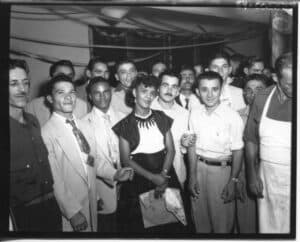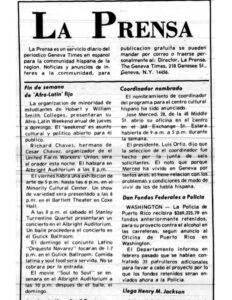The Spanish Association of the Finger Lakes
By Becky Chapin, Archivist
World War II marked a huge turning point in Geneva’s sources of labor in agriculture and factories. Like most of the country, a labor shortage affected all aspects of our industry, from farms to factories to railroads. A number of Black and Mexican laborers migrated seasonally to work for the local industry in addition to supplementation by women and eventually German and Italian prisoners of war. It wouldn’t be until a few years after the war that a steady trickle of migrants from Puerto Rico came to the area looking for jobs.
The 1950s were a difficult era to find housing in Geneva, especially affordable housing. A study by the League of Women Voters revealed that more than 500 persons in Geneva lived in substandard housing. The study prompted Mayor W Erle Rogers to create the Council for a Better Geneva in 1955. Viacita Fowler, already actively involved with the Spanish-speaking community, organized the Council as a non-partisan citizens committee.
But articles in the Democrat and Chronicle reveal that a group of Puerto Ricans had already organized themselves around 1954, led by Mario Torres. Torres had been invited to be the representative for the Family Services Board and reported difficulty in the community because “his people vehemently rejected any Charity from their fellow citizens.” Estimates on the number of Puerto Rican people living in Geneva in 1950 were about 250, but just several years later that number had grown to an estimation of 300 families living in Geneva with 3,000 living in the vicinity. The lure of jobs for work on farms and canneries meant an increasing population of Spanish-speakers who needed help navigating a predominately English-speaking community.
In 1956, the Council for a Better Geneva considered the creation of an office to help assimilate Puerto Rican families into Geneva. Lucy Glunz had already been a volunteer interpreter for city officials, relief administration, courts, schools, and police in addition to teaching classes for more than 4,000 Puerto Ricans attending St. Francis de Sales. The St. Francis deSales Church also hired Father José Mareno, a Cuban Jesuit studying sociology at Cornell, to be able to offer Spanish language services.
Despite these attempts to organize, it wasn’t until 1973 that a centralized office was opened as the Spanish Cultural Center on Exchange Street, without city support. The Center started its operations with grant funds from the office of Human Development of the Rochester Diocese. There are conflicting reports on the date of incorporation for the Spanish Association of the Finger Lakes (SAFL), but it was likely in 1973.
Its first president was Luis Ortiz, a member of the Geneva Police Department, and later the first Puerto Rican member of the school board when he was elected in 1975. At the time of his campaign, Luis spoke of the importance of bringing his insights and sensitivity to the problems of the city’s youth and low-income residents. He had also served on a defunct Community Relations Committee which had been organized to solve racial problems in the city schools.
The center and the SAFL were in dire need of funding by 1976. The original funding ran out in April of that year, but the center continued its operations into 1977 thanks to fundraising and donations. Requests for help from the Geneva Community Chest, a previous supporter, were turned down and requests to the city resulted in an ad hoc committee to help the SAFL in applying for government grants. This effort secured federal Comprehensive Employment and Training Act (CETA) funds which would help pay for staff and the building utilities and rent for the center.
Gloria Merced had been working as a volunteer until November 1976 when she was able to receive payment through a federal Manpower program administered by Ontario County. She helped community members make phone calls, doctor’s appointments, and translate letters. Merced would eventually become the Association president in 1977 during which time the SAFL would help sponsor the Women’s Resource Center.
The SAFL and Spanish Cultural Center offered numerous services to the Spanish-speaking community including: free transportation for doctor appointments, to and from hospitals, to the social services office in Canandaigua, and in emergency situations; assistance in finding employment and housing; agency referrals; help with small household repairs; Girl Scouts, Brownies, and 4-H; English classes; social events including celebrations of importance to their cultural heritage and a Miss Puerto Rico competition; a library; and interpretation services.
The longer the center was open, the more services it provided not only to the Spanish speaking community, but also other low-income families. Project coordinators at the Center include Tom Lucas, who was very outspoken about the city’s housing situation and how the city treated its minority groups. Alberto Ortiz would replace Lucas in 1978; Alberto had lived in Geneva since 1962 and attended Geneva High School and CCFL (now FLCC). His goals were to expand the membership and increase the number of board members to be able to better serve the community.
In 1979, Toni O’Malley replaced Alberto and expanded on a 10-year affirmative action plan to address housing, employment, education, recreation, social services, and transportation. She even started a newspaper called Nuestra Communidad Hispana in May 1979. “We want ‘Nuestra Communidad Hispana’ to become a voice of the people,” she said. The purpose was to inform the Spanish speakers and Geneva community at-large of the Association’s activities.
Soon after, the SAFL was able to secure funding to start the Youth Intervention Program, headed by Tom Lucas and later Bill Carroll, geared to serve not only Black, Hispanic, and minority youth, but all youth ages 13-19 in Ontario and Wayne counties. The program offered vocational assessment and apprenticeship placement; social/recreational activities; basic life skills and crafts; served as an emergency overnight shelter; offered counseling and referrals; and art, music, and video workshops. That program would fail to be funded by the State Division for the Youth in 1980.
By this time, the SAFL and Cultural Center estimated there were about 800 Spanish speaking people in Geneva and was the only functioning association for minorities. 1980 marked the lifting of the ban on emigration in Cuba by Fidel Castro and the SAFL sponsored Cuban refugees Amando Filgeira and Pedro Rodriguez who were the first to take up residence in the area in May. The two were staying with Romeo and Rayma Liberio and were assisted by the Genesee Ecumenical Council, a non-denominational church group in Rochester, to finance the trip.
Unfortunately, the Spanish Cultural Center would close just a month later because of financial difficulties. The CETA funding, which lasted for three years, ran out in September 1979 and the application for any further funding was not approved. In late July 1980, the SAFL was making plans to dissolve their incorporation and were hoping to pay their remaining debts. Its president, Pedro Padovani, was the only dissenting vote on the board for the dissolution. He said, “The association provided the people with a forum where, collectively, they could voice the comments, opinions, complaints, and send them on to government officials.”
Ever since taking my first and only Spanish class as a senior in college, I have been trying to learn the language. With a growing number of Spanish-speaking community members it’s important that their stories are captured in both languages. Unfortunately, I am still in beginner Spanish, so I can’t write this blog in both languages, but maybe one day we will be able to serve our community in that way.
In my research, I found other volunteers, board members, and staff involved in the group which include: Jose Merced, Sister Maria Cobos (of Sisters of Our Lady of Guadalupe in Rochester), Jose Serna, Alma Vega, Mona Jimenez, Mary Perez, Cesar Campos, Hildega Yulfo, Alfred Santiago, Fundador Caraballo, Carmen Rosario West, Lydia Rodriguez, Angela Yulfo Velez, Elaine Roberts, Marlene Madia Leichtweis, Gloria Blue, Christine Hoffman, John Acquilano, Rachel Plano, Charles Parker, Maria Rodriguez, Isabelle Church, Olga Torres, Dan Flood, and Dianne Whiting.
I have tried my best to verify dates and names, but the newspapers gave many conflicting details. If you know anything more about the SAFL or if I have gotten any information wrong, please email me directly at archivist@historicgeneva.org.





Thank you Becky.
Quite fascinating to see that there seemed to be more interest in helping the Hispanics, Blacks and other low income people in the 1970s and 80s than there is nowadays.
Thank you Becky. All communities could learn from this history. The needs of immigrants, especially those that do not have English as their first language, are ongoing and deserve more of our collective attention. I wonder what Geneva could be if it were to focus on this issue. In my view, it could make Geneva even more vibrant and attractive to us all.